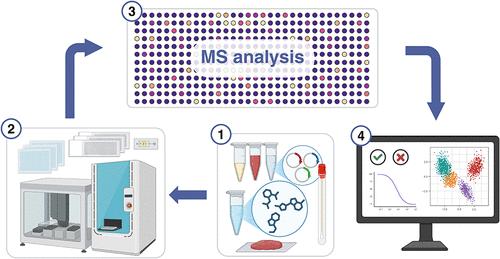25年高通量生物样品的质谱筛选:当前的平台和新兴的方法
IF 6.7
1区 化学
Q1 CHEMISTRY, ANALYTICAL
引用次数: 0
摘要
强大的高通量筛选(HTS)方法发现新的化学实体是理想的研究和翻译。特别需要高通量(HT)方法的应用还包括用于药物发现和开发的潜在治疗方法的筛选,用于疾病生物标志物发现的生物流体分析以及临床诊断。与特定应用领域对高温超导的需求相辅相成的是自动化、微流体和环境电离领域的实质性技术进步,这些技术进步促进了高度自动化和复杂的分析工作流程。从2000年到2025年,质谱(MS)的能力和技术得到了显著的发展。这包括新的电离方法,可以实现快速分析与最小的溶剂和样品消耗,同时保持高灵敏度和特异性在没有色谱。尽管对HTS方法的需求和MS良好的分析能力,光学方法仍然是首选的HTS检测方法。这一观点概述了过去25年来HTS-MS的发展,重点是新兴的方法,这些方法也提供了与光学检测竞争的高效和可持续的工作流程。此外,这一视角将突出该领域可能阻碍广泛采用的挑战,并考虑2019冠状病毒病大流行的教训,以及可持续性对HTS-MS和分析化学未来的影响。本文章由计算机程序翻译,如有差异,请以英文原文为准。

Twenty-Five Years of High-Throughput Screening of Biological Samples with Mass Spectrometry: Current Platforms and Emerging Methods
Robust high-throughput screening (HTS) approaches for discovering new chemical entities are desirable for research and translation. Applications for which high-throughput (HT) methods are particularly required also include the screening of potential therapeutics for drug discovery and development, profiling of biofluids for disease biomarker discovery, and clinical diagnostics. Complementing the demand for HTS from specific application areas are substantial technological advancements in the fields of automation, microfluidics, and ambient ionization that facilitate highly automated and sophisticated analytical workflows. The time period spanning 2000–2025 has witnessed a significant expansion in the mass spectrometry (MS) capabilities and technology. This has included novel ionization approaches that can achieve rapid analysis with minimal solvent and sample consumption, while retaining high sensitivity and specificity in the absence of chromatography. Despite the demand for HTS methods and the well-documented analytical capabilities of MS, optical methods dominate as the HTS detection methods of choice. This perspective provides an overview of the evolution of HTS-MS over the last 25 years, focusing on emerging approaches that also provide efficient and sustainable workflows that compete with optical detection. Additionally, this perspective will highlight challenges in the field that may hinder widespread adoption and consider lessons from the COVID-19 pandemic, as well as the impact of sustainability on the future of HTS-MS and analytical chemistry.
求助全文
通过发布文献求助,成功后即可免费获取论文全文。
去求助
来源期刊

Analytical Chemistry
化学-分析化学
CiteScore
12.10
自引率
12.20%
发文量
1949
审稿时长
1.4 months
期刊介绍:
Analytical Chemistry, a peer-reviewed research journal, focuses on disseminating new and original knowledge across all branches of analytical chemistry. Fundamental articles may explore general principles of chemical measurement science and need not directly address existing or potential analytical methodology. They can be entirely theoretical or report experimental results. Contributions may cover various phases of analytical operations, including sampling, bioanalysis, electrochemistry, mass spectrometry, microscale and nanoscale systems, environmental analysis, separations, spectroscopy, chemical reactions and selectivity, instrumentation, imaging, surface analysis, and data processing. Papers discussing known analytical methods should present a significant, original application of the method, a notable improvement, or results on an important analyte.
 求助内容:
求助内容: 应助结果提醒方式:
应助结果提醒方式:


